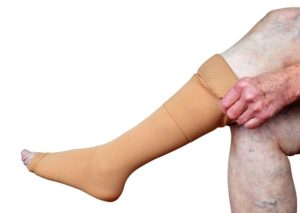
Results of a randomised controlled trial conducted at Imperial College, London, UK, have shown that the application of compression stockings is associated with a significant reduction in pain during the first few days following intervention. In addition, it was found by the study that patients undergoing endothermal ablation and phlebectomies benefited more from compression in the post-operative course.
The findings of the “Compression following endothermal ablation” (COMETA) investigation were reviewed by Roshan Bootun (Imperial College, London, UK) at the annual meeting of the American Vein and Lymphatic Society (AVLS; 7-10 November 2019, Phoenix, USA). Beginning, he said: “As we know from interventional treatment, most patients end up with bandaging for a variable period of time, followed by compression stockings, which are often worn for a very long period of time as well.”
Based on National Institute of Health and Care Excellence (NICE) guidelines in the UK, for the treatment of varicose veins in the legs, it is recommended that compression bandaging or hosiery, if offered, should only be used following interventional treatment for a maximum of seven days. In response to this, the COMETA study was launched, with the aim of testing compression after thermal ablation by establishing pain scores over the first 10 postoperative days.
According to the speaker, patients with reflux of the great saphenous vein (GSV) or small saphenous vein (SSV) were randomised to one of two groups, receiving compression stockings for seven days or no stockings at all. Stockings used in the study were Class II (18-24mmHg), and all patients wore them for the first 24 hours post-intervention. Furthermore, the multi-centre trial was conducted across two sites in London.
Overall, 206 symptomatic patients with venous reflux of more than 0.5 seconds were randomised into either the compression cohort (100 patients) or no compression group (104 patients). At two-week follow-up, a pain score from the first ten days was recorded as a primary outcome, as well as other secondary outcomes such as ecchymosis score, time to resume activities, and the venous clinical severity score (VCSS). In terms of baseline characteristics and veins treated between the two cohorts, there was no significant difference.
Bootun underlined that of those randomised to compression, 63% were maintained at follow-up, compared to 66% in the non-compression group. “If we look at the pain score using a visual analogue scale (VAS), we found that the results were significantly better in the compression group on days two, three and four,” the present revealed, before adding that “a subgroup analysis of patients who underwent interventional treatment with phlebectomy showed that the pain score was much better with compression stockings on days one to three, five and seven”.
Further analysis of the follow-up data showed that there was no significant difference between the groups after two weeks with regard to VCSS, generic quality of life, and disease-specific quality of life. Moreover, the time to return to normal activities between both cohorts was also similar.
The six-month follow-up data demonstrated very little difference in terms of complete occlusion rates (87.5% in the compression group vs. 92% in the non-compression group) and the incidence of deep vein thrombosis (with just one case recorded), while a similar improvement in clinical and quality of life scores was discovered at six months as well. Upon summarising the findings of COMETA, Bootun concluded further that “the effect of compression on endothermal ablation alone is still unclear”.













Did both groups undergo concomitant multiple phlebectomies?
My personal experience is that multiple phlebectomies cause more discomfort than an RF ablation. If phlebectomies were done, then the findings are not surpising — it was true in the era of vein stripping. The title might better be “Compression Useful After Multiple Phlebectomies.”
If phlebectomies were not done concomitantly, the duration of compression is much more than I see needful.
I always appreciate these clinical studies for superficial vein treatment. More are needed.